By Bill Adams
The Ohio River separates the United States Upper South and Lower Midwest regions. Opposite Cincinnati, Ohio, on the river’s Kentucky side is the city of Edgewood, home to Summit Fire Apparatus, owned by the Messmer family.
Summit is a half-mile from Interstate I-275, five miles from I-71 and I-75, six miles from downtown Cincinnati, and less than 20 miles from the Indiana border. The interstate highway labyrinth gives excellent access to both regions.
Edgewood
The Messmer family and Edgewood’s fire services have a longstanding relationship. From the City of Edgewood’s Web site: “The (fire) department was founded in 1955 under the name of Sandfordtown and Community Volunteer Fire Department and was staffed completely by volunteers. In 1961, the department changed its name to the Southern Hills Volunteer Fire Department when the station was relocated to the vicinity of our current location.”
Charles Messmer was Southern Hills’ fire chief from 1964 until 1969. His son Joseph “Joe” Messmer formed Southern Hills’ emergency medical services (EMS) group and was its EMS chief from 1970 to 1972. Robert “Louie” Messmer, another son, was fire chief from 1974 to 1980. Joe later served as the Southern Hills fire chief from 1980 to 1996.

1 Summit Fire Apparatus is located on Sperti Drive in Edgewood, Kentucky, close to the top of a “summit”—about six miles from downtown Cincinnati, Ohio. (Photos courtesy of Summit Fire Apparatus.)
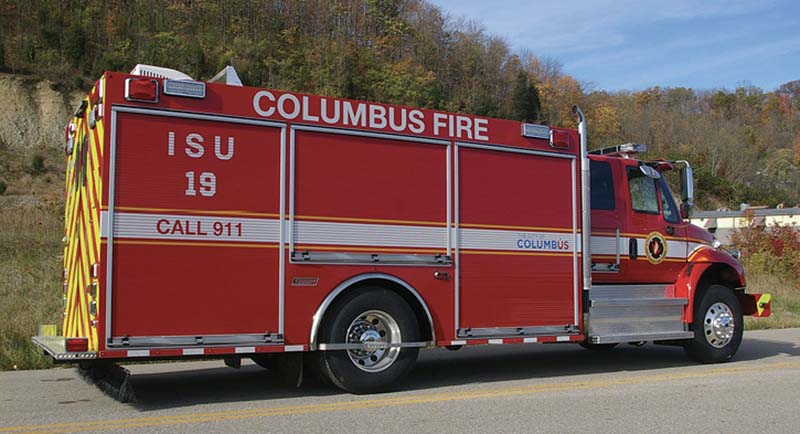
2 The Columbus (OH) Division of Fire took delivery of this Summit “Incident Support Unit” (air truck) featuring an aluminum body. It has an 80-kW generator, a 33.2-cfm @ 6,000-psi breathing air compressor with a 25-hp motor, fully enclosed fragmentation station, eight 6,000-lb. DOT cascade cylinders, 28-bottle SCBA cylinder storage, and four cable reels with 300-foot capacity of 10/3 cable each.

3 The Sharonville (OH) Fire Department operates this Summit dry chemical unit with a 2,500-lb. Purple K dry powder skid unit, four nitrogen supply cylinders, and an aluminum body on a four-door Ford F-550 chassis with a bumper-mounted TFT monitor.
From Edgewood’s Web site: “Then in 1996, the fire department corporation elected to transition from an independent department when it merged to become a part of the City of Edgewood Fire/EMS.” Joe was the Edgewood Fire/EMS fire chief from 1996 to 2006. Today, the department is a combination volunteer/career entity where Joe’s son, Mark, is a volunteer lieutenant. In January 2022, the Edgewood Fire/EMS Facebook page recognized Joe’s 55 years of service to the organization. During this time, the Messmers started and expanded a fire truck manufacturing company.
The Beginning
A 1986 Kentucky Post newspaper series titled “Made in Kentucky” featured Summit Fire Apparatus along with Joe and a third brother Thomas “Tom” Messmer: “Their father, Charles Messmer, started Summit Welding & Fabricating Company in his home in 1957. Mr. Messmer concentrated on general fabrication work and built fire trucks as a hobby.”
From Summit’s Web site: Two of Charles’s sons immediately followed in their father’s footsteps and came to work at Summit after school learning the trade of welding and fabricating from their father.
Joe elaborated: “Tom and I worked in the shop after high school classes ended for the day. I actually started working here while in grade school and occasionally during the week after school. It started in our Edgewood garage. In 1960, we rented a 6,000-square-foot building about a half-mile from our present location. Eight years later, we moved into the original building on Sperti Drive. In 1994, we doubled its size to about 32,000 square feet.” Their brother Louie also worked in the business for a short time before moving out of the area in the early 1980s.
Messmer’s first complete rig was a tanker built for the Walton (KY) Fire Department. Joe and Tom assumed ownership after Charles passed in 1969. In 1975, a DBA (doing business as) was registered for Summit Welding and Fabricating, incorporated to conduct business as Summit Fire Apparatus.
A Web site describing Summit had a misleading statement stating that Summit “… began purchasing and refurbishing pumpers for resale, including many from the FDNY.” Joe says, “That is only partially right. We never purchased apparatus and refurbished them for resale. Our associations with people in the FDNY (Fire Department of New York) enabled us to educate and assist communities with purchasing FDNY surplus apparatus. During competitive bidding back home, we were awarded several contracts to refurb some of them. That led us to doing more refurbs and repairs on local departments’ existing apparatus. We gained a lot of experience repairing other manufacturers’ apparatus. We saw how some newer apparatus builders were doing better jobs of fabricating trucks, thus making them last longer.” That is when Joe, then the president, and Tom, the vice-president, expanded the business from strictly repair and refurbishing into building complete apparatus.
Today
Joe says, “We still do a lot of repair and collision work on fire apparatus. Repairing fire trucks, especially older ones, isn’t the same as repairing an automobile. Collision repair often entails dealing with underlying rot, rust, and corrosion not directly attributed to an accident. While rust and corrosion must be addressed, there must be close coordination with insurance carriers because most believe rust repair is separate from collision repair. There should be no surprises.
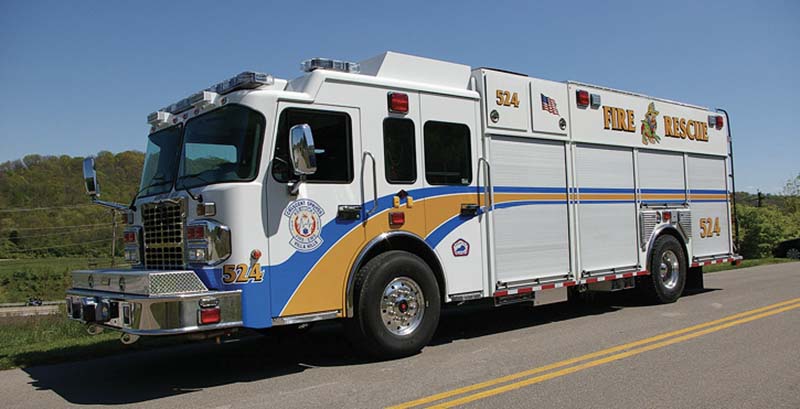
4 The Crescent Hills-Villa Springs (KY) Fire Department operates this Summit fully enclosed aluminum pumper-rescue on a Spartan custom chassis with a 1,500-gpm pump and a 750-gallon fiberglass booster tank with an integral foam tank piped to three crosslays. It carries two full sets of rescue tools, multiple electric rewind hose and cable reels, and water/ice rescue equipment and is equipped with a 20-kW hydraulic generator, an electrically operated roll-up hosebed cover, and an extended front bumper. The rig responds as part of the Northern Kentucky Technical Rescue Team.
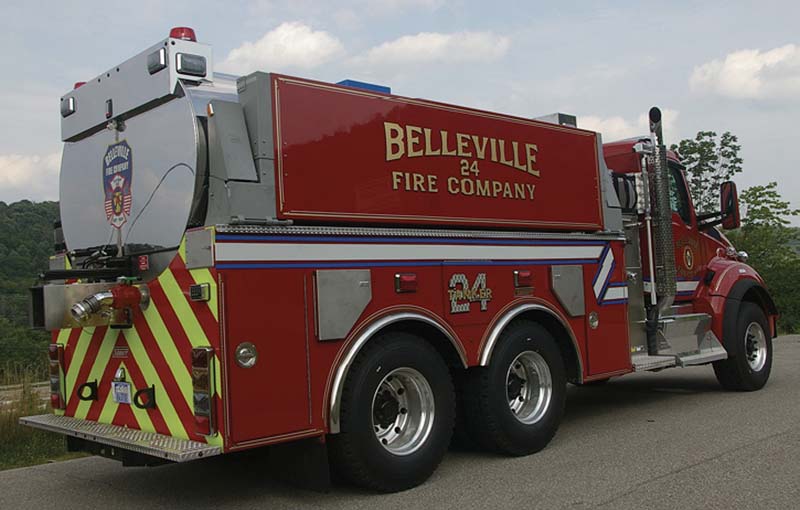
5 The Belleville (PA) Fire Company runs this aluminum Summit tanker with a 3,000-gallon polished stainless steel wrapped elliptical tank. It has a 1,000-gpm pump, a powered portable tank storage system, and recessed side dump valves on a tandem two-door Kenworth chassis. Many of Summit’s elliptical tankers feature unique “top caps” on the front and rear to mount warning and scene lights.
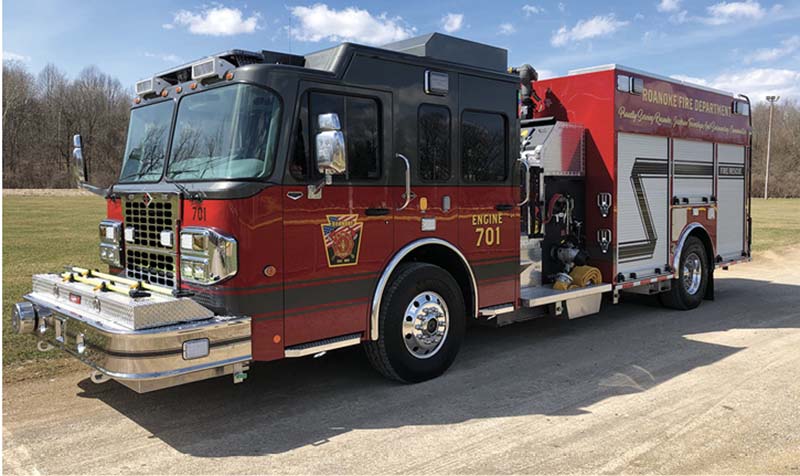
6 The Roanoke (IN) Fire Department operates an aluminum Summit pumper on a Spartan custom chassis with a 1,500-gpm pump with top-mount controls. It has a 1,000-gallon poly tank with a 20-gallon foam tank and a 10-kW hydraulic generator. The extended front bumper has two hose wells plus extrication tool storage.
“We want to ensure everyone is happy and the unit is in good shape before it leaves our shop. Repairing and refurbishing other manufacturers’ apparatus gave us excellent insight in how to better build our own. We saw how not to build trucks and made sure we didn’t do the same.
“Many departments have chosen to or are forced to keep vehicles longer. Some install new bodies on their existing chassis. Others will keep a well-built and maintained body and install it on a new chassis. We can refurbish those units at a considerable savings over buying new. It is a niche market, and we’ve re-missioned many trucks. It was an opportunity to expand our business and still is today.”
In addition to repair and collision work, Summit builds about 15 new rigs a year with around 18 employees. Joe manages sales and oversees production and manufacturing. Tom is in charge of custom fabrication work and manages the metal inventory. Joe’s son Mark, the shop foreman, maintains the production schedule and supervises the shop employees.
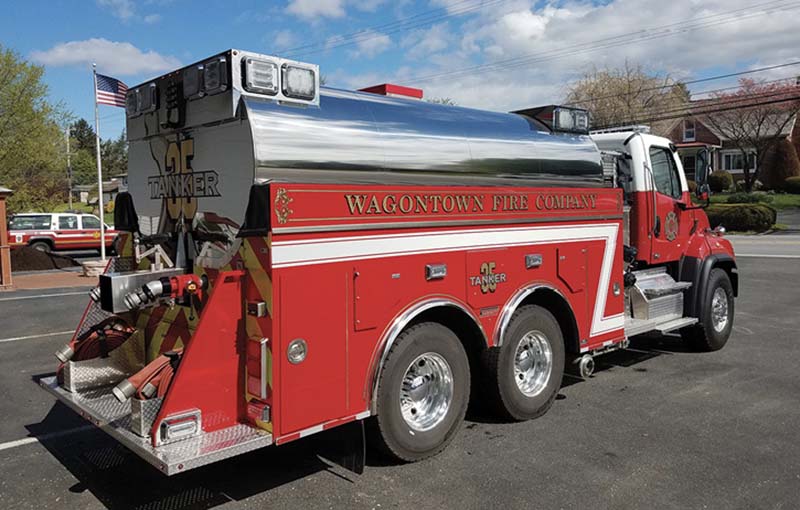
7 The Wagontown (PA) Fire Department has a 3,000-gallon elliptical tanker with a 1,000-gpm PTO-operated pump and an aluminum Summit body. Dump valve controls are in the Freightliner cab. The extended rear step protects rear tank connections and provides extra storage.
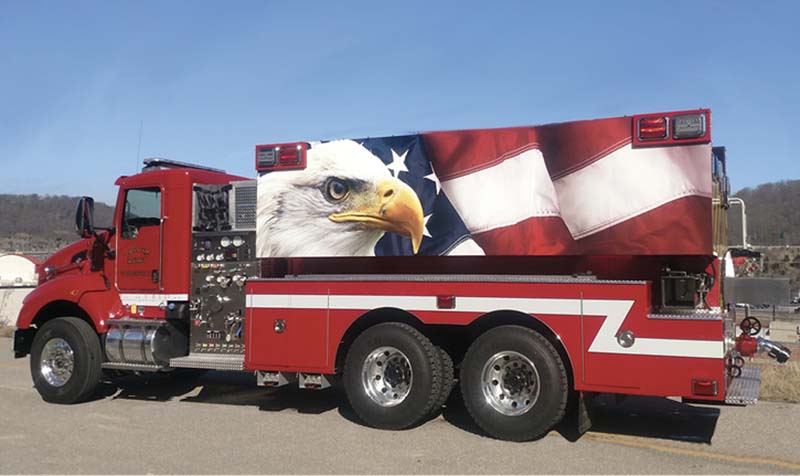
8 The Tioga (NY) Fire District’s Summit tanker has a 3,000-gallon poly tank, an aluminum body, and a 1,250-gpm pump with a pump house heat pan and heater mounted on a Kenworth chassis.

9 The Van (WV) Volunteer Fire Department has a Summit rescue with an aluminum body and an 8-kW hydraulic generator body material mounted on a four-door Ford F-550. The compartments aft of the rear tires have been shortened to provide an increased angle of departure.
Joe Messmer Interview
Do any other employees have fire service experience?
“Besides myself and my son Mark, we have a volunteer, a retired volunteer, and a full-time firefighter on staff.”
Do you do many warning and scene light upgrades?
“Absolutely. Changing out old lights adds a safety feature, as the newer lights are brighter, and makes the unit look less dated.”
What’s your preferred building material? “Mostly formed aluminum with extruded aluminum substructure. We use no dissimilar metals on the subframes.”
Do you do much stainless steel fabricating?
“About 20% of our trucks are stainless steel.”
Do you do much galvanneal?
“It has been years since we’ve used galvanneal.”
Do you use “poly” bodies?
“We have looked at them but haven’t decided yet.”
Do you use “poly” tanks?
“Yes, we do; we also use fiberglass.”
Are your brush trucks (grass fire trucks) built to the NFPA 1906 standard?
“Yes, we adhere to the NFPA 1906 standards for all brush/grass trucks.”
Will you build tankers to the NFPA 1906 standard?
“Yes.”
Is there a preference for single or tandem axled chassis on tankers?
“It has been a 50/50 split over the past 10 years. This year, it leans more toward the larger tandem axle trucks. We’re also seeing a lot more tankers with larger capacity pumps that are not true (NFPA 1901) compliant pumpers with hosebeds and equipment. We’re seeing consistent requests for trucks with expanded pumping capabilities for a variety of reasons.”
What’s the most common pumper tank capacity?
“It’s more by type of community. Some with hydrants request anything from 500 to 1,000 gallons, and rural companies request anywhere from 750 to 2,000 gallons.”
What’s the most common pumper pump capacity?
“1,250 followed by 1,500 gallons per minute (gpm).
What’s the most common apparatus built?
“We do a good average of pumpers, tankers, and rescue trucks. We’ve been doing some industrial pumpers as well as specialty units like breathing air vehicles.”
Are you seeing more multifunction rigs?
“That seems to be the way many departments are going for two major reasons—economical and personnel.”
Do you do much service?
“Our service department is available 24 hours a day. Don’t forget, there’s a difference between preventive maintenance, emergency repairs, scheduled repair and collision work, as well as refurbishing of older units. Summit does all four.”
Where did the name Summit come from?
“My father was an entrepreneur who had several businesses, some with partners who didn’t always work out. After his last venture, he decided to start his own in our garage. He wanted no more partners but said if any of his sons wanted to come into the business, that would be fine. Three of us did. There was a subdivision and several businesses near us with the name Summit. Our area is on top of a hill, so he just decided to call it Summit.”
Has COVID-19 affected your day-to-day operations?
“It has. We had to learn patience. Production and sales slowed. When the pandemic was at its highest, we almost entirely locked down our facilities with limited access for our customers. We took all the directed safety measures to best limit exposure or spread and to keep us fully operational. We have had several employees out with COVID. Others stayed home when exposure was known. They did not return until they tested negative despite most of the time being asymptomatic. Many of our suppliers were shut down or running on limited staff. Representatives were working from home and only operating via e-mail. It could take days for a response. We had to rely heavily on our best suppliers and call on alternate sources to complete our jobs. We are still dealing with these things today because of supply chain interruptions.”
Is the current “state of the economy” negatively affecting business?
“Most definitely. The pandemic and inflation are a perfect storm of trouble for business in general. If the delayed delivery times due to the pandemic weren’t challenging enough, material prices skyrocketing has given us new challenges. We have struggled with price security on anything we quote. Price adjustments for material and products have been a daily chore to stay on top of. It has been difficult trying to explain to customers that our suppliers are not securing their prices to us because of the turbulent marketplace and the longer delivery times. Surcharges or material increases are being applied that cannot be absorbed without price adjustments of our own. Chassis manufacturers are adding surcharges to trucks after we issued a purchase order because of material shortages and production delays. We either pay it or they do not deliver the truck. It forces a company like us to forecast material pricing more than ever and be creative in how we secure our pricing as well as consider changes in our procurement methods depending on the type of job coming through the shop. It really has been difficult. We are not sure when or if we will return to business as usual.”
Are there any customer preferences for custom or commercial cabs and chassis?
“It hasn’t changed that much. We find it is mostly determined by type of apparatus and budget. Tankers are more likely to be built on commercials. Pumpers and heavy rescues tend to prefer customs. Budget is still the determining factor, especially for the volunteer market. However, with grants and the introduction of limited-option custom chassis models, we would say we see a trend toward looking at custom. The pandemic and inflation have both commercial and custom truck prices up.”
Are purchasers using co-ops like HGAC rather than doing competitive bidding?
“Yes. We are on several state contracts as well as HGAC and have several under contract using the co-ops. We see a trend of suburban departments choosing this method over bidding. We have to say we are for the use of the co-ops and use of state contracts. Initially, we were reluctant to embrace the co-op. We honestly felt it would be a boondoggle. However, we have found fire departments like it. We have been blessed with some good customers who explained the positives of and advocated for us to participate in these programs. The customers work directly on the spec for the truck they want with little compromise. They can get the price right away so they can know if it supports their budget; and, with no formalized bidding process, they can get their truck ordered and delivered faster.”
Are customers content with “cookie-cutter trucks” or do they want to “sit down and design a rig” explicitly for their department?
“Most departments we work with really want their truck custom designed to meet their needs. That’s really the niche for a smaller builder like Summit. We build those trucks that are just a little different than cookie-cutter trucks offered by larger builders. Over the years, I have yet to meet a department that feels a ‘cookie cutter’ will fit all their needs. Sometimes, a truck takes a new approach or design for something truly custom. Other times, it’s as simple as a couple of items that separate it from a cookie-cutter truck. But, those few items can be critical to the function of that apparatus for that department. Our knowledge of innovative products and production flexibility allows us to excel with this type of customer.”
When competitive bidding, are purchasers more interested in low bid (regardless of compliance) or do they demand bidders follow the specs?
“More and more fire departments are finding out the lowest price is not always the best option. I see more due diligence today in investigating bid specifications and manufacturers and searching for who has the better-quality truck at the most reasonable price.”
What’s more common, proprietary specs or open and performance-based specs?
“I would say they are about the same. In a not-too-distant past, it was more proprietary, but I see the customers are wanting the best for their dollar and prefer specs to be more open.”
Are there many negotiated sales?
“Yes. Mostly through the state contracts or after the contract, we see more requests for different options because that department has been informed about new products or products that offer other features which better enhance their apparatus.”
Any pro or con comments about NFPA 1901?
“I feel 1901 has been beneficial to the fire service, especially in advocating for safer apparatus. Though I will admit, I wonder how some items made it into the standard and exactly who some of these items are benefiting.”
Why is formed aluminum your preferred building material?
“I do feel it’s a stronger building practice. I am aware of the hoopla of extrusion building and higher tensile strengths. We cannot deny that an extrusion has tensile strength and has advantages in expediting production, but its weakness is at the weld. I can show you how we can bend and form and weld material that can take as much bending if not more than an extrusion. We do a lot of collision repair of all different brands of bodies. As a builder, we have built using all methods and know the pros and cons of each method.”
What’s more common, walk-in or walk-around rescue trucks?
“We definitely see more walk-around rescues, and it has been that way for over 25 years. Customers understand that they are losing a large amount of storage space just to have a very small and cumbersome walk-in space. Additionally, the price difference is so great for the walk-in because you have to finish the inside as well as the outside of the unit, often including HVAC in the body. The savings of the walk-around allow a department to purchase a custom cab where the firefighters already have HVAC and a safe, secure riding location.”
What are some of your unique builds?
“We have been building air and light trucks for over 40 years; I feel when comparing ours to others that we build the best in the business. We have built them with all different drive systems available but found the electric method to be the least trouble to operate and maintain. We offer unique options in bottle storage and arrangement as well as a variety of equipment and layouts. I also find our pumper-rescues to be the most innovative and safest in the industry. Summit gained a reputation as rescue builders. Even though we have always had a whole line of apparatus, it was our innovation like drop frames or bumper extensions in rescues that most remember, and it’s that experience that we carry into our pumper-rescues. We apply those rescue features like maximized storage space, fully equipped front bumper extensions, and auto-raise safety rails to our pumper-rescues and I believe it makes them stand out above the others.”
Any comments about the apparatus industry?
“If you look at the current list of manufacturers, it’s looking like there are no medium range builders. I have to wonder how this will affect our industry going forward.”
Any words of wisdom for apparatus purchasers?
“Customers are missing out in some cases when they only buy apparatus from the bigger, more commercially prominent builders. I feel the small builder has so much more to offer—better ability, flexibility, and affordability and a lower pressure experience.”
. . .
Summit has come a long way since Charles Messmer started building fire trucks as a hobby.
BILL ADAMS is a member of the Fire Apparatus & Emergency Equipment Editorial Advisory Board, a former fire apparatus salesman, and a past chief of the East Rochester (NY) Fire Department. He has 50 years of experience in the volunteer fire service.

